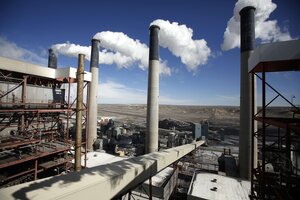Is your hometown a top hit for climate change?
A group of scientists used 14 years of data to map climate change hot spots around the globe. But they didn't just map extreme weather – they analyzed the response of local vegetation.

Steam rises from the stakes of the coal-fired Jim Bridger Power Plant outside Point of the Rocks, Wyoming, in this file photo taken March 14, 2014. The U.S. Supreme Court on Tuesday delivered a major blow to President Barack Obama by blocking federal regulations to curb carbon dioxide emissions from power plants, the centerpiece of his administration's strategy to combat climate change.
Jim Urquhart/Reuters
North American prairies, South American rainforests, and eastern Australia are all climate change hot spots, according to a paper published Wednesday in the journal Nature.
Alistair Seddon, lead author of the study and a biologist at the University of Bergen in Norway, analyzed 14 years of NASA satellite images with four of his colleagues to identify areas around the world that are ecologically sensitive to climate change.
Instead of just predicting how the climate will change in different parts of the world, Dr. Seddon and his colleagues looked at vegetation changes from 2000 to 2013 in response to monthly changes in air temperature, water availability, and cloud cover.
Accounting for the “three climatic variables that drive vegetation productivity,” the scientists produced the Vegetation Sensitivity Index. The VSI serves as a map of their findings, with the most vulnerable ecosystems in red and the least sensitive regions in green.
“Understanding how ecosystems are going to respond to climate variability is an important feature that we still don’t have a lot of information on,” Seddon told The Washington Post. “And so what our study is doing is providing that perspective at a global scale.”
Some regions may have witnessed dramatic vegetation changes over 14 years amid inconsequential temperature change, earning the categorization of "highly sensitive" on the index. Conversely, some areas witnessed serious climate changes, but they still scored low on the sensitivity index because the local vegetation remained stable.
To put it simply, Seddon and his collegaues say we should worry about the areas with sensitive vegetation, not the areas that experience the most extreme weather changes. Because if an area has mild weather changes, but serious sensitivity, future effects of climate change will be even more severe.
Alfredo Huete, a professor of plant functional biology and climate change at the University of Technology Sydney, praises the unbiased approach to Seddon’s study. By simply organizing satellite observations, Seddon and his team avoid making hypothesized assumptions on ecological tolerance limits.
“However, satellite information is only one piece of the larger picture,” adds Dr. Huete, “and needs to be integrated with information collected on the ground if we are to fully understand the functional properties of vegetation communities” and what they say about climate change. Because other information, such as the age of the forests and relative levels of biodiversity, can improve the VSI’s accuracy.
And Thomas Lovejoy, an ecologist at George Mason University who studies the Amazon rainforest, gives a similar analysis.
The new study is “an important advance,” he told The Washington Post, “But it is by definition an underestimate of sensitivity because biological interactions [like coral bleaching and bark beetles] show major ecosystem impacts can occur on top of and as part of vegetation or ecosystem impacts.”
But Seddon agrees. Simply organizing vegetation’s different responses is the first step, he says.
“Now we have this global picture, it can guide the next areas of research,” Seddon tells the Huffington Post. “Ecosystems are likely going to have to face multiple dimensions of climate change in the future – increases in average temperatures, no-analogue conditions – but understanding how they will respond to variability is also a key knowledge gap.”
VSI analyzes relative response rate of ecosystems, explain the authors, “which is the first step towards addressing why some regions appear to be more sensitive than others, and what impact this has on the resilience of ecosystem service provision and human well-being.”

